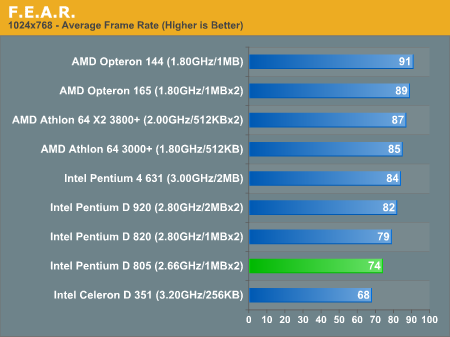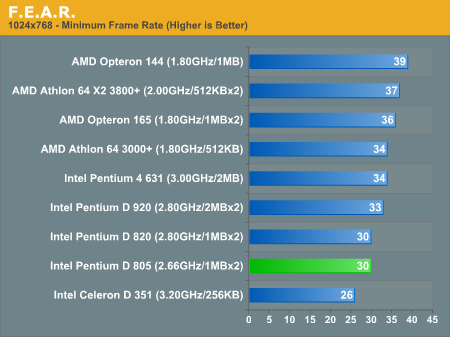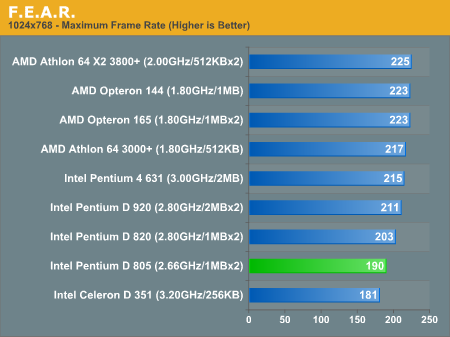Intel Pentium D 805 - Dual Core on a Budget
by Anand Lal Shimpi on April 7, 2006 12:00 AM EST- Posted in
- CPUs
Gaming Performance using F.E.A.R. and Quake 4



F.E.A.R. shows the Pentium D 805 and the rest of the Intel crowd falling to the bottom of the chart. The Athlon 64 3000+ enjoys its largest margin of victory here, offering a 15% advantage over the Pentium D 805.

We included Quake 4 with its new 1.1 patch because the patch enables SMP support; SMP was enabled on both Hyper-Threading and dual core CPUs, which is why you see them outperforming their single-core counterparts. If more games took advantage of SMP in the same manner as Quake 4, the Pentium D 805 would be a fairly strong gaming CPU. In reality, there are only two current PC games offering SMP support: Quake 4 and Call of Duty 2, and the former benefits much more than the latter.










51 Comments
View All Comments
Nick5324 - Friday, April 7, 2006 - link
Agree, good stuff! I'm looking forward to the overclocking write up.whitelight - Friday, April 7, 2006 - link
i liked how you included a large variety of cpu's. thanks!lifeblood - Friday, April 7, 2006 - link
Having read all the reviews of EE this and XF that, I was starting to think my poor little +3000 was ready for the garbage heap. After reading this article I was very happy to see my +3000 still does quite well in office productivity and games which is it's primary use. I guess I will keep it around another year before upgrading to an X2.PrinceGaz - Friday, April 7, 2006 - link
Superb article Anand, this is the kind of article I like; a test that includes all of the likely alternative chips that might be considered and where something useful is said under each graph instead of just presenting page after page of graphs with no comments. Okay so I look at the graphs first and make my own mind up, but it's always good to see what someone else thinks in each test to see if I missed something important. I look forward to more articles like this; hopefully the Pentium D 805 overclocking article will also look at overclocking the other chips, not just the 805.The one error I refer to is that although the Celeron D processor is correctly identified as having 256KB L2 cache in pages 2 and 3 of the article, on all of the graphs (page 4 onwards) it says 512KB. Shouldn't take long to fix.
Dfere - Friday, April 7, 2006 - link
I liked the article- not for the graphs. I rad the beginning, some of the set up and the conclusions, and the comments. I am not a tech head! I agree it is nice to get a broad based analysis/market comparison, especially on the "value" segment orbusiness stuff. (CPA here).JarredWalton - Friday, April 7, 2006 - link
Fixed, thanks! (Not as easy to correct as you might suspect... graphs require a bit more effort, but at least it was only one change per graph.)YellowWing - Friday, April 7, 2006 - link
No mention of 64 bit support in the 805, is 64 bit possible?Viditor - Friday, April 7, 2006 - link
Yes...
FSB = 533 MHz
Cache = 2x1MB
Clockspeed = 2.66 GHz
Virtualization = No
Enhanced Speed Step = No
EM64T = Yes
YellowWing - Friday, April 7, 2006 - link
ThanksJackPack - Friday, April 7, 2006 - link
Yes, of course.